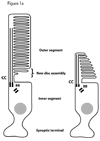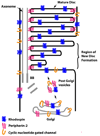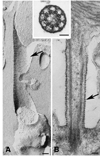Intraflagellar transport and the sensory outer segment of vertebrate photoreceptors
- PMID: 18489002
- PMCID: PMC2692564
- DOI: 10.1002/dvdy.21554
Intraflagellar transport and the sensory outer segment of vertebrate photoreceptors
Abstract
Analysis of the other segments of rod and cone photoreceptors in vertebrates has provided a rich molecular understanding of how light absorbed by a visual pigment can result in changes in membrane polarity that regulate neurotransmitter release. These events are carried out by a large group of phototransduction proteins that are enriched in the outer segment. However, the mechanisms by which phototransduction proteins are sequestered in the outer segment are not well defined. Insight into those mechanisms has recently emerged from the findings that outer segments arise from the plasma membrane of a sensory cilium, and that intraflagellar transport (IFT), which is necessary for assembly of many types of cilia and flagella, plays a crucial role. Here we review the general features of outer segment assembly that may be common to most sensory cilia as well those that may be unique to the outer segment. Those features illustrate how further analysis of photoreceptor IFT may provide insight into both IFT cargo and the role of alternative IFT kinesins.
Copyright (c) 2008 Wiley-Liss, Inc.
Figures







Similar articles
-
The Role of Intraflagellar Transport in the Photoreceptor Sensory Cilium.Adv Exp Med Biol. 2016;854:627-33. doi: 10.1007/978-3-319-17121-0_83. Adv Exp Med Biol. 2016. PMID: 26427468 Review.
-
Intraflagellar transport: A critical player in photoreceptor development and the pathogenesis of retinal degenerative diseases.Cytoskeleton (Hoboken). 2024 Nov;81(11):556-568. doi: 10.1002/cm.21823. Epub 2023 Dec 23. Cytoskeleton (Hoboken). 2024. PMID: 38140908 Review.
-
The homodimeric kinesin, Kif17, is essential for vertebrate photoreceptor sensory outer segment development.Dev Biol. 2008 Apr 1;316(1):160-70. doi: 10.1016/j.ydbio.2008.01.025. Epub 2008 Jan 31. Dev Biol. 2008. PMID: 18304522 Free PMC article.
-
Analysis of IFT kinesins in developing zebrafish cone photoreceptor sensory cilia.Methods Cell Biol. 2009;93:219-34. doi: 10.1016/S0091-679X(08)93012-0. Epub 2009 Dec 4. Methods Cell Biol. 2009. PMID: 20409820
-
Protein networks and complexes in photoreceptor cilia.Subcell Biochem. 2007;43:209-35. doi: 10.1007/978-1-4020-5943-8_10. Subcell Biochem. 2007. PMID: 17953396 Review.
Cited by
-
Protein partners of dynamin-1 in the retina.Vis Neurosci. 2013 Jul;30(4):129-39. doi: 10.1017/S0952523813000138. Epub 2013 Jun 10. Vis Neurosci. 2013. PMID: 23746204 Free PMC article.
-
Environmental responsiveness of tubulin glutamylation in sensory cilia is regulated by the p38 MAPK pathway.Sci Rep. 2018 May 30;8(1):8392. doi: 10.1038/s41598-018-26694-w. Sci Rep. 2018. PMID: 29849065 Free PMC article.
-
The Ran importin system in cilia trafficking.Organogenesis. 2011 Jul-Sep;7(3):147-53. doi: 10.4161/org.7.3.17084. Epub 2011 Jul 1. Organogenesis. 2011. PMID: 21791971 Free PMC article.
-
Large-scale analysis reveals spatiotemporal circadian patterns of cilia transcriptomes in the primate brain.J Neurosci Res. 2021 Oct;99(10):2610-2624. doi: 10.1002/jnr.24919. Epub 2021 Jul 26. J Neurosci Res. 2021. PMID: 34310750 Free PMC article.
-
Protrusion-Derived Extracellular Vesicles (PD-EVs) and Their Diverse Origins: Key Players in Cellular Communication, Cancer Progression, and T Cell Modulation.Biol Cell. 2025 Jun;117(6):e70018. doi: 10.1111/boc.70018. Biol Cell. 2025. PMID: 40500981 Free PMC article. Review.
References
-
- Adato A, Lefevre G, Delprat B, Michel V, Michalski N, Chardenoux S, Weil D, El-Amraoui A, Petit C. Usherin, the defective protein in Usher syndrome type IIA, is likely to be a component of interstereocilia ankle links in the inner ear sensory cells. Hum Mol Genet. 2005;14:3921–3932. - PubMed
-
- Bae YK, Qin H, Knobel KM, Hu J, Rosenbaum JL, Barr MM. General and cell-type specific mechanisms target TRPP2/PKD-2 to cilia. Development. 2006;133:3859–3870. - PubMed
Publication types
MeSH terms
Grants and funding
LinkOut - more resources
Full Text Sources

